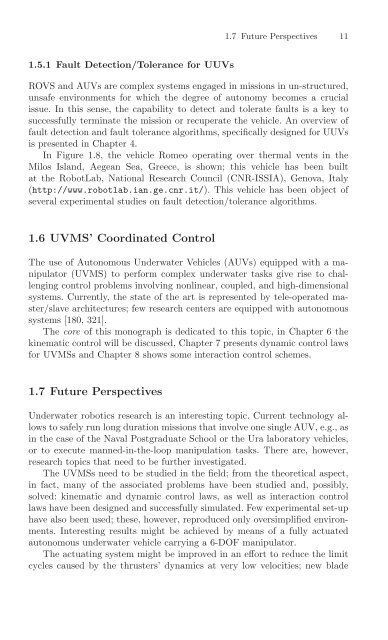Underwater Robots - Gianluca Antonelli.pdf
Underwater Robots - Gianluca Antonelli.pdf
Underwater Robots - Gianluca Antonelli.pdf
You also want an ePaper? Increase the reach of your titles
YUMPU automatically turns print PDFs into web optimized ePapers that Google loves.
1.5.1 Fault Detection/Tolerance for UUVs<br />
1.7 Future Perspectives 11<br />
ROVS and AUVs are complex systems engaged in missions in un-structured,<br />
unsafe environments for which the degree of autonomy becomes acrucial<br />
issue. In this sense, the capability todetect and tolerate faults is akey to<br />
successfully terminate the mission or recuperate the vehicle. Anoverview of<br />
fault detection and fault tolerance algorithms, specifically designed for UUVs<br />
is presented in Chapter 4.<br />
In Figure 1.8, the vehicle Romeo operating over thermal vents inthe<br />
Milos Island, Aegean Sea, Greece, is shown; this vehicle has been built<br />
at the RobotLab, National Research Council (CNR-ISSIA), Genova, Italy<br />
( http://www.robotlab.ian.ge.cnr.it/). This vehicle has been object of<br />
several experimental studies on fault detection/tolerance algorithms.<br />
1.6 UVMS’ Coordinated Control<br />
The use of Autonomous <strong>Underwater</strong> Vehicles (AUVs) equipped with amanipulator<br />
(UVMS) to perform complex underwater tasks give rise to challenging<br />
control problems involving nonlinear, coupled, and high-dimensional<br />
systems. Currently, the state of the art is represented by tele-operated master/slave<br />
architectures; few research centers are equipped with autonomous<br />
systems [180, 321].<br />
The core of this monograph isdedicated to this topic, in Chapter 6the<br />
kinematic control will be discussed, Chapter 7presents dynamic control laws<br />
for UVMSs and Chapter 8shows some interaction control schemes.<br />
1.7 Future Perspectives<br />
<strong>Underwater</strong> robotics research isaninteresting topic. Current technology allows<br />
to safely run long duration missions that involve one single AUV, e.g., as<br />
in the case of the Naval Postgraduate School or the Ura laboratory vehicles,<br />
or to execute manned-in-the-loop manipulation tasks. There are, however,<br />
research topics that need to be further investigated.<br />
The UVMSs need to be studied in the field; from the theoretical aspect,<br />
in fact, many ofthe associated problems have been studied and, possibly,<br />
solved: kinematic and dynamic control laws, as well as interaction control<br />
laws have been designed and successfully simulated. Fewexperimental set-up<br />
have also been used; these, however, reproduced only oversimplified environments.<br />
Interesting results might beachieved by means of afully actuated<br />
autonomous underwater vehicle carrying a6-DOF manipulator.<br />
The actuating system might beimproved inaneffort to reduce the limit<br />
cycles caused by the thrusters’ dynamics at very low velocities; new blade






